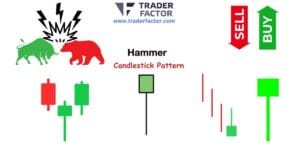Price action is a trading approach that focuses solely on analyzing the movement of prices. It doesn’t rely on additional indicators or tools, making it straightforward for beginners to grasp. By examining price changes, you can identify patterns, trends, and key levels that help predict future movements. Whether you’re aiming to trade short-term or long-term, understanding price action equips you to make decisions using pure market data. This guide will explore the essential concepts of price action and how to apply it effectively in forex trading for better outcomes.
Table of Contents
ToggleWhat is Price Action?
Price action refers to the study of historical price movements to guide trading decisions. Instead of using technical indicators or algorithms, you rely entirely on how prices behave on a chart. It is purely visual and easy to learn because the focus is on candlestick patterns, price levels, and chart formations.
By using price action, you get insights into the collective behavior of traders in the market. This approach helps you see clear trends and pinpoint potential entry and exit opportunities. For beginners, price action is appealing as it simplifies decision-making without complex tools.
Price Action Trend Trading
Price action trend trading revolves around identifying price trends and trading in their direction. Trends are essential because they show where the market is heading. Whether a trend is upward or downward, price action allows you to confirm it by examining higher highs, higher lows, or lower highs and lower lows.
Using price action, you can stay in sync with the market’s rhythm, taking advantage of predictable movements. For example, if the price forms consecutive higher lows, you can assume the uptrend will likely continue. Understanding how trends work helps you position yourself for success by avoiding trades that go against the flow.
Price Movements and Trend Lines
To fully understand price action trading, price movements and trend lines are two integral components. They help traders identify trends, make informed decisions, and capture profitable opportunities in the forex market. Below is an expanded discussion on these concepts.
Understanding Price Movements
Price movements are the foundation of analyzing trends in trading. They reflect how market participants react to supply and demand, economic news, and technical signals. By observing price movements, you gain insight into whether a currency pair is trending upward, downward, or moving sideways. Upward movements suggest bullish sentiment, meaning buyers dominate the market. Conversely, downward movements indicate bearish sentiment, highlighting selling pressure. Lateral or sideways movements often signify a consolidating market where neither buyers nor sellers control the trend. Understanding these shifts in momentum enables you to align your trades with the prevailing trend.
Drawing Effective Trend Lines
Trend lines are among the simplest yet most effective tools in forex trading. They are diagonal lines that connect significant high points in a downtrend or significant low points in an uptrend. Drawing a trend line begins by identifying at least two or more price points. For example, in an uptrend, mark the lowest low and the next higher low; for a downtrend, connect the highest high to the next lower high. Ensure your trend lines are clean and touch multiple points for accuracy. Extending trend lines into the future helps you anticipate areas where price action may react, offering potential trade entry or exit points.
Using Trend Lines in Trading Decisions
Trend lines serve as dynamic support and resistance levels. For instance, in an uptrend, the line acts as a support, indicating that prices are likely to rebound from it. Conversely, in a downtrend, the trend line acts as resistance, signaling that prices may reverse downward upon touching it. Traders often use these lines for timing their trades, entering when prices approach the trend line and bounce back in line with the overall trend. Breakouts, where prices breach a trend line, are another significant signal. A breakout above a downward trend line might indicate the start of an uptrend, while a break below an upward trend line could predict a downtrend.
Common Mistakes with Trend Lines
Although trend lines seem straightforward, there are common errors traders make when using them. One frequent mistake is redrawing trend lines too often to fit current price movements, which distorts the analysis. Another is forcing a trend line where no clear trend exists, often leading to false signals. Additionally, relying solely on trend lines without confirming other signals, such as candlestick patterns or volume changes, reduces their effectiveness. Always treat trend lines as tools that work best when complemented by a broader analysis.
Trend lines and price movements are powerful when used in combination. They offer a clear structure to market behavior and guide you in navigating potential opportunities. By practicing how to draw, interpret, and act upon trend lines, you can enhance your price action trading strategy and make more robust forex trading decisions.
Support and Resistance Levels
Support and resistance levels are foundational concepts in price action trading. Support refers to a price level where a currency pair consistently stops falling and tends to reverse upwards. Think of it as a “floor” that the price struggles to break below. Resistance, on the other hand, acts as a “ceiling” where prices face difficulty rising further and are likely to reverse downward. These levels are not precise numbers but zones, often influenced by historical price patterns, market sentiment, and trader behavior.
How to Identify Support and Resistance Levels
Identifying these levels starts by observing past price behavior. Look at areas where prices have repeatedly reversed direction, either halting a downtrend or uptrend. For example, if a currency pair frequently bounces back from the $1.2000 level, that point becomes a potential support zone. Conversely, if prices regularly fail to move above $1.3000, that level becomes significant resistance. Tools like trend lines and horizontal lines are extremely useful for marking these zones on a chart.
Candlestick Patterns and Their Role
Candlestick patterns also play a major role when analyzing support and resistance. If a currency’s price approaches a support zone and forms bullish candlestick patterns, such as an engulfing pattern, it could indicate a potential reversal upwards. Similarly, bearish patterns near a resistance level, like shooting stars, might signal an impending drop. By combining these patterns with price action, you gain stronger signals for decision-making.
Role of Volume in Validating Levels
Volume analysis adds another layer of accuracy. Higher trading volumes near these zones often validate the strength of support or resistance. For instance, if the price begins to rise from a support level with an increase in volume, it signals strong buyer activity. Conversely, low volumes in these zones may suggest weak momentum, increasing the chances of a breakout.
Tools and Techniques for Analysis
Traders frequently use additional techniques to refine their analysis of support and resistance levels. Trend lines and channels can highlight the overall market direction while marking key obstacle zones along the way. Consolidation zones, where prices move sideways, often indicate areas of strong support or resistance. Furthermore, tools like pattern recognition AI, automated charting software, and alerts help traders identify these levels efficiently. For example, pattern scanners can detect double bottoms or head-and-shoulders patterns near support or resistance zones, providing actionable insights.
Practical Example of Support and Resistance
Consider a scenario where the euro/dollar pair is trading in a range, consistently bouncing between $1.0800 (support) and $1.1200 (resistance). A trader notices the price testing $1.0800 for the third time, forming a hammer candlestick with rising volume. This signal confirms that buyers are stepping in strongly at the support level. Therefore, entering a buy trade here with a target around $1.1200 and a stop-loss slightly below $1.0800 would align with the principles of price action trading.
Importance of Support and Resistance in Trading
Support and resistance levels are crucial because they reflect the psychology of the market. Knowing where large buying or selling interest tends to occur helps you anticipate price movements. These levels can guide entry and exit decisions, determine stop-loss placement, and even set profit targets. For beginners, mastering support and resistance analysis is a stepping stone toward understanding market dynamics and improving trading outcomes. By incorporating tools like candlestick patterns, volume analysis, and trend lines, your interpretation of these levels can become more precise and actionable.Price Action vs Other Strategies
Unlike strategies that rely heavily on indicators like moving averages or stochastic oscillators, price action relies solely on the raw data displayed by price charts. While indicators may add convenience, they often lag behind actual price movements, creating delays that could compromise your trades. With price action, you make decisions in real-time based on current price developments.
For example, price action eliminates dependence on algorithms, giving you more control over your trades. Meanwhile, complex strategies relying on indicators like RSI or Bollinger Bands might cloud your judgment by presenting too much conflicting information. Beginners often appreciate price action for its simplicity and focus.
Price Action Signals
Price action signals are essential tools for traders seeking clear entry and exit points. These signals emerge from the natural movement of prices on a chart, free from the clutter of additional indicators. They often take the form of candlestick patterns or reactions to key levels, such as support and resistance. By interpreting these signals accurately, you can make well-informed, timely trading decisions that follow the market’s behavior.
Understanding Price Action Signals
At their core, price action signals are cues derived from how prices behave in the market. These signals help you predict potential market direction based on past and current price movements. They might appear as sudden changes in momentum, repeated patterns, or price rejections at significant levels. Traders value these signals because they are rooted in raw price data, offering clarity without relying on complex systems or lagging indicators.
Breakouts as Signals
One powerful price action signal is the breakout. A breakout occurs when the price moves beyond a predefined level, such as breaking above a resistance zone or below a support zone. For instance, if a currency pair has historically failed to rise above $1.1500 and suddenly surges past this threshold, it signals an increase in bullish momentum. Breakouts indicate potential new trends or expansions in market activity and can prompt traders to enter positions in the direction of the breakout.
However, not all breakouts are reliable. False breakouts, where prices briefly go beyond a level before reversing, can lead to costly mistakes. To avoid this, confirm breakouts using volume analysis. High volume during a breakout often suggests strong conviction from buyers or sellers, making the signal more trustworthy.
Reversals and Their Significance
Reversals are another key price action signal. They occur when the market changes direction, often after rejecting a support or resistance level. For example, if a currency pair repeatedly tests a resistance level and fails to break through, resulting in downward movement, this signals a reversal. Reversals are critical because they warn traders of potential trend changes, helping them recalibrate their strategies.
To strengthen the reliability of reversal signals, traders often look for additional confirmation, such as candlestick formations like hammers or engulfing candles. These patterns, when occurring near key levels, provide added confidence in the reversal.
Using Candlestick Patterns for Signals
Candlestick patterns are among the most visual and reliable price action signals. These formations are created by individual candlesticks or combinations of them, each telling a story about market sentiment. For instance:
- A bullish engulfing pattern forms when a small bearish candlestick is followed by a larger bullish one, indicating a shift from selling pressure to buying strength.
- A doji candlestick represents indecision and often precedes reversals, especially near support or resistance levels.
- A hammer candle at the bottom of a downtrend suggests strong buying interest and a potential reversal upwards.

By observing these patterns and their context within the broader trend, you can adapt your trading decisions. For example, spot a hammer candlestick near a strong support level, and it could be a signal to enter a buy position with a favorable risk-to-reward ratio.
Importance of Price Action Signals
Price action signals are critical for their simplicity and effectiveness. They strip away the noise created by redundant tools and allow you to focus on the most important aspect of trading, the price itself. By learning to identify breakouts, reversals, and candlestick patterns, you can better anticipate market movements, reduce the risks of impulsive decisions, and act with confidence. Incorporating these signals into your forex strategy bridges the gap between analysis and action, leading to more consistent trading performance.
Price Action Patterns
Price action patterns are powerful visual cues that allow you to understand and predict market behavior. These patterns emerge from the natural movement of prices over time and are often repeated due to consistent human and market behavior. They primarily help you identify whether an asset’s price is about to change direction or continue in the same path, offering a crucial advantage for informed forex trading decisions.
Understanding Price Action Patterns
Price action patterns form as a result of identifiable price movements on charts. These formations, such as head and shoulders, double tops, wedges, flags, and more, represent the collective sentiment of buyers and sellers. By recognizing these patterns, you can act preemptively rather than reactively, positioning yourself favorably in the market. Each pattern conveys its own story about what traders are doing and what the market might do next.

For instance, if you notice a double top pattern at the end of an uptrend, it typically indicates that buyers are losing momentum, and a reversal to the downside may occur. Similarly, flags and wedges during strong trends suggest a temporary pause before the trend likely resumes.
Reversal Patterns and Their Importance
Reversal patterns signal a change in the current trend’s direction. Spotting them allows you to prepare for shifts, whether you’re entering a new position or exiting an existing one. Common reversal patterns include:
- Head and Shoulders: This pattern predicts a downward reversal. It forms when the price creates three peaks, with the middle peak (head) higher than the two surrounding peaks (shoulders). The completion of the pattern typically leads to a bearish move.
- Double Tops and Double Bottoms: A double top signals that the price is struggling to break above a resistance level, often leading to a downward reversal. Conversely, double bottoms are seen at the end of a downtrend and suggest the price is likely to reverse upward.
- Engulfing Candlestick Patterns: A bearish engulfing candle near resistance or a bullish engulfing candle near support are common reversal signals that reflect shifts in market control.
Continuation Patterns and Their Role
Continuation patterns occur when the market pauses momentarily before resuming its primary trend. These patterns are ideal for traders wanting to identify when to stay in a trade and benefit from the overall trend’s strength. Some popular continuation patterns include:
- Flags and Pennants: Both these patterns signify brief consolidations in a strong trend. A flag appears as a small rectangular shape, while a pennant takes a triangular form. Both suggest the existing trend will resume after the pause.
- Wedges: A rising wedge often indicates a potential downturn, whereas a falling wedge suggests a possible upward continuation. Wedges occur when price action narrows over time, showing a period of reduced volatility before a breakout.
- Triangles: Symmetrical triangles often signal continuation. However, traders monitor for breakouts to confirm the trend’s direction.

Using Price Action Patterns to Make Trading Decisions
Knowing how to identify and interpret these patterns is essential for profitable forex trading. Reversal patterns guide you to adjust positions ahead of trend changes, while continuation patterns help you remain aligned with prevailing trends. For higher accuracy, combine these patterns with tools like volume analysis and support and resistance levels. For instance, if a symmetrical triangle breaks out in the direction of the trend and is accompanied by strong volume, it confirms the continuation signal.
Price Action Triggers
Price action triggers are key moments when market conditions align to prompt your trading decision. These include price interacting with support and resistance, breaking through consolidation zones, or reacting to chart patterns. Identifying these triggers allows you to fine-tune your market entries and exits.
Triggers can also involve price gaps or retests of critical levels after a breakout. These subtle movements can give you an edge when planning your next trade.
Consolidation Zones and Breakouts
Consolidation zones occur when prices move sideways in a tight range, hinting at indecision among traders. Recognizing breakouts from these zones often results in catching strong trends that stem from this built-up tension.
Price Action and Technical Analysis
Price action is widely regarded as the heart of technical analysis, offering traders raw insights into market behavior through the study of price movements. While price action alone provides valuable information, combining it with additional technical tools enhances its effectiveness and depth. Below, we explore how price action integrates with technical analysis to improve decision-making in forex trading.

The Role of Price Action in Technical Analysis
Price action forms the backbone of technical analysis, focusing solely on the movement of prices over time. It simplifies trading by excluding lagging indicators and instead relies on elements like trends, support and resistance levels, and candlestick formations. By analyzing these components, traders can decipher market sentiment and make informed predictions about potential price movements.
For example, spotting a bearish engulfing candlestick at a resistance level may flag a potential reversal, even without the use of complex indicators. This direct approach allows traders to react quickly and align with real-time market dynamics, making price action a versatile starting point for technical analysis.
Combining Price Action with Volume Analysis
While price action is powerful on its own, coupling it with volume analysis can provide a clearer picture of market activity. Volume reflects the strength of buying or selling pressure accompanying price movements, helping traders validate patterns or breakouts.
For instance, imagine a breakout above a well-established resistance level. If accompanied by high trading volumes, it confirms strong market interest and increases the likelihood of the breakout’s success. However, if the breakout occurs on low volume, it could signal a false move, warning traders to exercise caution. Using volume in tandem with price action ensures more reliable trading decisions.

Leveraging Chart Overlays and Other Tools
Chart overlays, such as moving averages, can act as valuable supplements to price action analysis. Moving averages help smooth price fluctuations and highlight trends, providing additional context to price action. For example, if price forms a bullish engulfing pattern near a 50-day moving average, which acts as a support level, it reinforces the strength of the bullish signal.
Fibonacci retracement levels also pair well with price action. By overlaying Fibonacci levels, traders can pinpoint potential reversal zones or pullback levels within a prevailing trend. When price aligns with key Fibonacci levels and forms recognizable patterns like hammers or spinning tops, it boosts the trader’s confidence in predicting the next move.
Leveraging Technology for Enhanced Price Action Trading
Modern trading platforms and tools, such as TradingView, have revolutionized the way traders analyze price action. Platforms like these offer advanced features like real-time alerts, automated pattern recognition, and customizable chart options. These tools enhance efficiency by reducing the time spent manually scanning for patterns or monitoring key levels.

For example, automated charting software can instantly highlight a head and shoulders formation or flag a bullish wedge. Alerts can notify traders when price reaches a critical support or resistance level, enabling quick action. Such functionality is particularly valuable for traders who rely on price action as a core component of their trading strategy but also want flexibility and speed.
How to Trade Price Action in Forex
Trading price action starts with observing trends, recognizing support and resistance levels, and identifying price action patterns. First, study charts to understand market rhythm. Next, look for signals like breakouts or reversals around key levels.
To improve accuracy, learn to draw trend lines and use them to assess momentum. Combine these with candlestick patterns like engulfing candles to confirm trades. Enter trades only when signs align, and exit by setting stop-loss and take-profit levels.
Remember, practice is essential. Real-time analysis builds confidence and sharpens your skills over time.
Examples of Price Action in Forex
Price action trading is a versatile and insightful method for analyzing the forex market. Real-world examples bring this approach to life and help traders understand how to apply its principles effectively. Below are some illustrative scenarios that showcase how price action can be used to identify opportunities and make informed trading decisions.

Identifying Support and Resistance Levels
Support and resistance levels are some of the most reliable and actionable aspects of price action. These levels represent price zones where buying or selling pressure repeatedly interrupts market trends, creating opportunities for entry or exit.
For example, consider a forex pair like EUR/USD that consistently reverses near the $1.1000 level on several occasions. This area is considered a support zone, as the price fails to breach it decisively, bouncing upward each time. On the other hand, if the pair consistently encounters selling pressure at $1.1200, this level becomes a resistance zone.
Traders use these patterns to anticipate potential reversals. For instance, if EUR/USD approaches $1.1000 again and forms a bullish candlestick pattern like a hammer, it could signal a buying opportunity. Identifying these zones on your charts through horizontal lines or other tools ensures you have a clear roadmap of where price action might react.
Using Timeframes for Price Action Analysis
Timeframes play a crucial role in price action trading, catering to diverse trading styles and objectives. Different timeframes reveal varying aspects of price behavior, helping traders tailor their strategies according to their goals.

- Day Traders often rely on shorter timeframes, such as 15-minute or hourly charts. These charts provide detailed insights into intraday movements, making them perfect for capturing small, quick price swings. For example, a breakout from a consolidation zone on a 15-minute chart could signal an intraday trading opportunity.
- Swing Traders focus more on daily or four-hour charts, as these provide a broader view of price trends. For instance, if a forex pair is forming higher highs and higher lows on a daily chart, it indicates a potential uptrend. A trader might then wait for a pullback to a support level before entering the market.
Learning from Gold Price Action
Gold (XAU/USD) is a popular asset for studying price action, particularly for beginners, because of its pronounced trends and well-formed patterns. Gold often follows clear levels of support, resistance, and breakouts, making it a textbook example of how price behaves in response to market forces.

For example, during periods of economic uncertainty, gold tends to climb as a safe-haven asset. Traders can observe how gold reacts to news or key levels on a chart. Suppose gold approaches a significant resistance level, like $2,000 per ounce, and forms a bearish candlestick pattern, such as a shooting star. This could signal a reversal or pullback, providing an opportunity for short trades.
Additionally, gold frequently consolidates in tight ranges before decisive breakouts. By analyzing how price moves within these ranges, traders can position themselves for potential profit when a breakout occurs.
Conclusion
Price action in forex gives you a direct insight into market movements. By understanding trends, patterns, and signals, you can trade confidently. Practical tools and consistent practice enhance your ability to make smart decisions. Price action is a reliable tool, even for beginners, which simplifies trading and promotes success over time. Start exploring charts today and unlock better trading results.
Frequently Asked Questions

Which is the best price action strategy?
The best price action strategy depends on your trading style. Common approaches include breakouts, trend following, and trading key support/resistance levels.
How to study price action in forex?
Study price action by analyzing charts, focusing on trends, patterns, and candlestick formations. Practice observing how price reacts to support, resistance, and key levels.
Which indicator is best for price action?
Price action itself doesn’t rely heavily on indicators, but tools like moving averages or volume analysis can complement your analysis.

Is price action strategy profitable?
Yes, price action can be profitable if applied consistently and with proper risk management. It helps traders understand market behavior directly.
How to read price action like a pro?
Master reading charts, identifying key zones, spotting candlestick patterns, and understanding the story behind price movements. Regular practice is key.
How to calculate price action?
Price action isn’t calculated; it’s observed by analyzing raw price data, such as highs, lows, and closes, from charts.
What is better than price action?
While price action is powerful, combining it with tools like volume analysis or fundamental insights adds depth and precision to trading strategies.

Which chart is best for price action?
Candlestick charts are the most effective for price action analysis as they visually represent market sentiment and key levels.
How to learn price action strategy?
You can learn through online courses, trading books, and hands-on practice by analyzing forex charts regularly to identify patterns and trends.
How do you use MACD with price action?
Use MACD to confirm price action signals. For example, align MACD crossovers with a breakout from a consolidation zone for added confidence.
What is the tool for price action trading?
Trading platforms like TradingView offer tools such as candlestick charting, support/resistance lines, and automated pattern recognition.
What is an example of a price action?
A bullish engulfing candle forming at a support level is a classic example of price action, signaling a potential reversal.
Which book is best for price action trading?
Books like “Al Brooks’ Trading Price Action Series” are highly regarded for in-depth insights into price action trading.
What are the most accurate price action patterns?
Reversal patterns like head and shoulders, and continuation patterns like flags are among the most accurate and reliable in price action trading.
Disclaimer:
All information has been prepared by TraderFactor or partners. The information does not contain a record of TraderFactor or partner’s prices or an offer of or solicitation for a transaction in any financial instrument. No representation or warranty is given as to the accuracy or completeness of this information. Any material provided does not have regard to the specific investment objective and financial situation of any person who may read it. Past performance is not a reliable indicator of future performance.
















